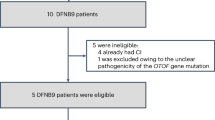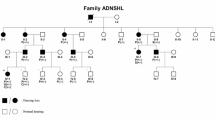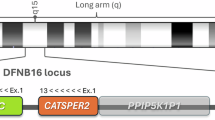Abstract
Previously only two families were known with progressive autosomal recessive deafness 103 (DFNB103, OMIM616042) caused by pathogenic variants of the CLIC5 gene. In this study we present the novel truncating variant c.644 G > A p.(Trp215*) of this gene which was found in homozygous state among 22 patients with hearing loss (HL) from 16 unrelated families living in the Sakha Republic of Russia (Eastern Siberia). Genotype-phenotype analysis in patients with DFNB103 showed that HL was sensorineural, symmetrical and variable by severity (from moderate to profound). Audiograms mostly have a down curve configuration, with pronounced loss of high and mid frequencies. In most cases this form of HL was detected in the post-lingual period (mean age 7.9 ± 1.2 years) and has a significant severity progression with age. In average the patients with DFNB103 lost 7.4 ± 13.65 dB on the speech frequency range in pure tone averages (PTA0.5,1.0,2.0,4.0 kHz) per year until reaching profound deafness in the second or third decade of the life. The high frequency of c.644 G > A p.(Trp215*) was found among Siberian GJB2-negative patients (9.9%) and this variant was not detected in GJB2-negative patients of Caucasian descent (predominantly Russians). The haplotype analysis based on the 730,000 whole genome SNP-markers indicates common origin of all studied mutant chromosomes. We conclude that the high prevalence of DFNB103 in Eastern Siberia is the result of founder effect, which occurred ~2500 years ago (~78 generations). These findings expand our knowledge of causative role of pathogenic variants in CLIC5 gene to the etiology of the HL.
This is a preview of subscription content, access via your institution
Access options
Subscribe to this journal
Receive 12 print issues and online access
$259.00 per year
only $21.58 per issue
Buy this article
- Purchase on SpringerLink
- Instant access to full article PDF
Prices may be subject to local taxes which are calculated during checkout




Similar content being viewed by others
References
Morton CC, Nance WE. Newborn Hearing Screening - a Silent Revolution. New Engl J Med. 2006;354:2151–64. https://doi.org/10.1056/NEJMra050700.
Del Castillo I, Morín M, Domínguez-Ruiz M, Moreno-Pelayo MA. Genetic Etiology of Non-Syndromic Hearing Loss in Europe. Hum Genet. 2022;141:683–96. https://doi.org/10.1007/s00439-021-02425-6.
Del Castillo FJ, Del Castillo I DFNB1 Non-Syndromic Hearing Impairment: Diversity of Mutations and Associated Phenotypes. Front Mol Neurosci: 2017, 10; https://doi.org/10.3389/fnmol.2017.00428.
Smith RJH, Azaiez H, Booth K. GJB2-Related Autosomal Recessive Nonsyndromic Hearing Loss. 1998 Sep 28 In: Adam MP, Feldman J, Mirzaa GM, Pagon RA, Wallace SE, Bean LJH, et al. editors. GeneReviews® [Internet]. Seattle (WA): University of Washington, Seattle; 1993–2024
Mignon C, Fromaget C, Mattei MG, Gros D, Yamasaki H, Mesnil M. Assignment of connexin 26 (GJB2) and 46 (GJA3) genes to human chromosomes 13q11-q12 and mouse chromosome 14D1-E1 by in situ hybridization. Cytogenet Cell Genet. 1996;72:185–6. https://doi.org/10.1159/000134183.
Kikuchi T, Kimura R, Paul DL, Adams JC. Gap junctions in the rat cochlea: immunohistochemical and ultrastructural analysis. Anat Embryol. 1995, 191; https://doi.org/10.1007/BF00186783.
Kelsell DP, Dunlop J, Stevens HP, Lench NJ, Liang JN, Parry G, et al. Connexin 26 mutations in hereditary non-syndromic sensorineural deafness. Nature. 1997;387:80–83. https://doi.org/10.1038/387080a0.
Chan DK, Chang KW. GJB2-associated hearing loss: Systematic review of worldwide prevalence, genotype, and auditory phenotype. Laryngoscope. 2014;124:E34–E53. https://doi.org/10.1002/lary.24332.
Adadey SM, Wonkam-Tingang E, Twumasi Aboagye E, Nayo-Gyan DW, Boatemaa Ansong M, Quaye O, et al. Connexin Genes Variants Associated with Non-Syndromic Hearing Impairment: A Systematic Review of the Global Burden. Life. 2020;10:258. https://doi.org/10.3390/life10110258.
Snoeckx RL, Djelantik B, Van Laer L, Van de Heyning P, Van Camp G. GJB2 (connexin 26) mutations are not a major cause of hearing loss in the Indonesian population. Am J Med Genet A. 2005;135A:126–9. https://doi.org/10.1002/ajmg.a.30726.
Zainal SA, Md Daud MK, Abd Rahman N, Zainuddin Z, Alwi Z. Mutation detection in GJB2 gene among Malays with non-syndromic hearing loss. Int J Pediatr Otorhinolaryngol. 2012;76:1175–9. https://doi.org/10.1016/j.ijporl.2012.04.027.
Yuan Y, Zhang X, Huang S, Zuo L, Zhang G, Song Y, et al. Common molecular etiologies are rare in nonsyndromic Tibetan Chinese patients with hearing impairment. PLoS ONE. 2012;7:30720 https://doi.org/10.1371/journal.pone.0030720.
Yang XL, Bai-Cheng X, Chen XJ, Pan-Pan B, Jian-Li M, Xiao-Wen L, et al. Common molecular etiology of patients with nonsyndromic hearing loss in Tibetan, Tu nationality, and Mongolian patients in the northwest of China. Acta Otolaryngol. 2013;133:930–4. https://doi.org/10.3109/00016489.2013.795288.
Erdenechuluun J, Lin YH, Ganbat K, Bataakhuu D, Makhbal Z, Tsai CY, et al. Unique spectra of deafness-associated mutations in Mongolians provide insights into the genetic relationships among Eurasian populations. PLoS ONE. 2018;13:e0209797. https://doi.org/10.1371/journal.pone.0209797.
Pshennikova VG, Teryutin FM, Cherdonova AM, Borisova TV, Solovyev AV, Romanov GP, et al. The GJB2 (Cx26) Gene Variants in Patients with Hearing Impairment in the Baikal Lake Region (Russia). Genes. 2023;14:1001. https://doi.org/10.3390/genes14051001.
Adadey SM, Wonkam-Tingang E, Aboagye ET, Quaye O, Awandare GA, Wonkam A. Hearing loss in Africa: current genetic profile. Hum Genet. 2022;141:505–17. https://doi.org/10.1007/s00439-021-02376-y.
Dia Y, Adadey SM, Diop JPD, Aboagye ET, Ba SA, De Kock C, et al. GJB2 Is a Major Cause of Non-Syndromic Hearing Impairment in Senegal. Biology. 2022;11:795. https://doi.org/10.3390/biology11050795.
Barashkov NA, Dzhemileva LU, Fedorova SA, Teryutin FM, Posukh OL, Fedotova EE, et al. Autosomal recessive deafness 1A (DFNB1A) in Yakut population isolate in Eastern Siberia: Extensive accumulation of the splice site mutation IVS1+1G>A in GJB2 gene as a result of founder effect. J Hum Genet. 2011;56:631–9.
Solovyev AV, Kushniarevich A, Bliznetz E, Bady-Khoo M, Lalayants MR, Markova TG, et al. A common founder effect of the splice site variant c.-23 + 1G > A in GJB2 gene causing autosomal recessive deafness 1A (DFNB1A) in Eurasia. Hum Genet. 2022;141:697–707. https://doi.org/10.1007/s00439-021-02405-w.
Teryutin FM, Pshennikova VG, Solovyev AV, Romanov GP, Fedorova SA, Barashkov NA. Genotype-phenotype analysis of hearing function in patients with DFNB1A caused by the c.-23+1G>A splice site variant of the GJB2 gene (Cx26). PLoS ONE. 2024;19:0309439. https://doi.org/10.1371/journal.pone.0309439.
Barashkov NA, Pshennikova VG, Posukh OL, Teryutin FM, Solovyev AV, Klarov LA, et al. Spectrum and Frequency of the GJB2 Gene Pathogenic Variants in a Large Cohort of Patients with Hearing Impairment Living in a Subarctic Region of Russia (the Sakha Republic). PLoS ONE. 2016;11:e0156300. https://doi.org/10.1371/journal.pone.0156300.
Romanov GP, Barashkov NA, Teryutin FM, Lashin SA, Solovyev AV, Pshennikova VG, et al. Marital Structure, Genetic Fitness, and the GJB2 Gene Mutations among Deaf People in Yakutia (Eastern Siberia, Russia). Russian J Genet. 2018;54:554–61. https://doi.org/10.1134/S1022795418050071.
Clark JG. Uses and abuses of HL classification. ASHA. 1981;23:493–500.
Fedorova SA, Popova SA, Mordosova ML, Starostina MI. Generation length in the Yakut population in the XVIII-XIX centuries. Yakut Med J. 2023;83:21–24. https://doi.org/10.25789/YMJ.2023.83.05.
Gagnon LH, Longo-Guess CM, Berryman M, Shin JB, Saylor KW, Yu H, et al. The chloride intracellular channel protein CLIC5 is expressed at high levels in hair cell stereocilia and is essential for normal inner ear function. J Neurosci. 2006;26:10188–98. https://doi.org/10.1523/JNEUROSCI.2166-06.2006.
Seco CZ, Oonk AM, Domínguez-Ruiz M, Draaisma JM, Gandía M, Oostrik J, et al. Progressive hearing loss and vestibular dysfunction caused by a homozygous nonsense mutation in CLIC5. Eur J Hum Genet. 2015;23:189–94. https://doi.org/10.1038/ejhg.2014.83.
Wonkam-Tingang E, Schrauwen I, Esoh KK, Bharadwaj T, Nouel-Saied LM, Acharya A, et al. Bi-Allelic Novel Variants in CLIC5 Identified in a Cameroonian Multiplex Family with Non-Syndromic Hearing Impairment. Genes. 2020;11:1249. https://doi.org/10.3390/genes11111249.
Adadey SM, Wonkam-Tingang E, Alves de Souza Rios L, Aboagye ET, Esoh K, Manyisa N, et al. Cell-based analysis of CLIC5A and SLC12A2 variants associated with hearing impairment in two African families. Front Genet. 2022, 13; https://doi.org/10.3389/fgene.2022.924904.
Acknowledgements
We thank all the patients and blood sample donors who contributed to this study.
Funding
This study was supported by the YSC CMP project “Study of the genetic structure and burden of hereditary pathology of the populations of the Republic of Sakha (Yakutia)” and by the Ministry of Science and Higher Education of the Russian Federation (FSRG-2023-0003).
Author information
Authors and Affiliations
Contributions
Conducted and designed the experiments and wrote the paper: VGP, FMT, TVB and NAB; Conducted the experiments: GPR, AMC, IVM, AAB and AVS analyzed the data: VGP, FMT, TVB, and AAN; collected the samples: FMT, VGP; discussed and proofed the paper: VGP, FMT, TVB, SAF and NAB.
Corresponding author
Ethics declarations
Competing interests
The authors declare no competing interests.
Ethical approval
Written informed consent was obtained from all patients participating in the study. The study was conducted according to the guidelines of the Declaration of Helsinki and approved by the local Biomedical Ethics Committee at the Yakut Scientific Center of Complex Medical Problems, Yakutsk, Russia (Yakutsk, protocol No. 16 of 16 April 2009).
Additional information
Publisher’s note Springer Nature remains neutral with regard to jurisdictional claims in published maps and institutional affiliations.
Supplementary information
Rights and permissions
Springer Nature or its licensor (e.g. a society or other partner) holds exclusive rights to this article under a publishing agreement with the author(s) or other rightsholder(s); author self-archiving of the accepted manuscript version of this article is solely governed by the terms of such publishing agreement and applicable law.
About this article
Cite this article
Pshennikova, V.G., Teryutin, F.M., Borisova, T.V. et al. The c.644 G > A p.(Trp215*) founder variant in the CLIC5 gene causes progressive autosomal recessive deafness 103 (DFNB103) in Eastern Siberia. J Hum Genet (2025). https://doi.org/10.1038/s10038-025-01406-1
Received:
Revised:
Accepted:
Published:
DOI: https://doi.org/10.1038/s10038-025-01406-1



